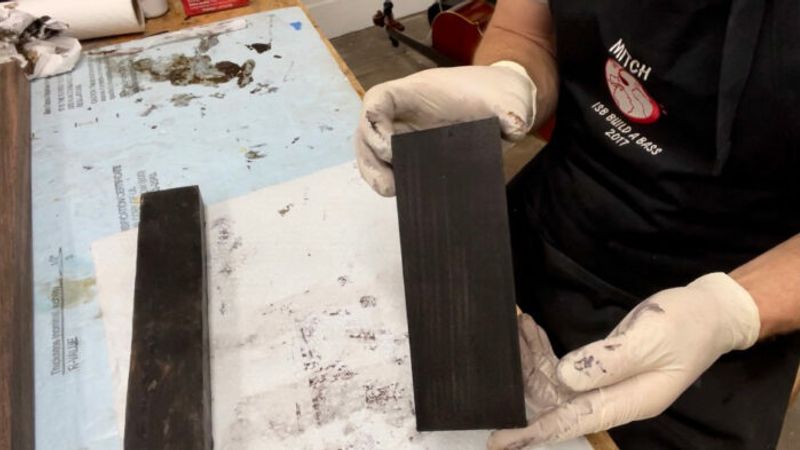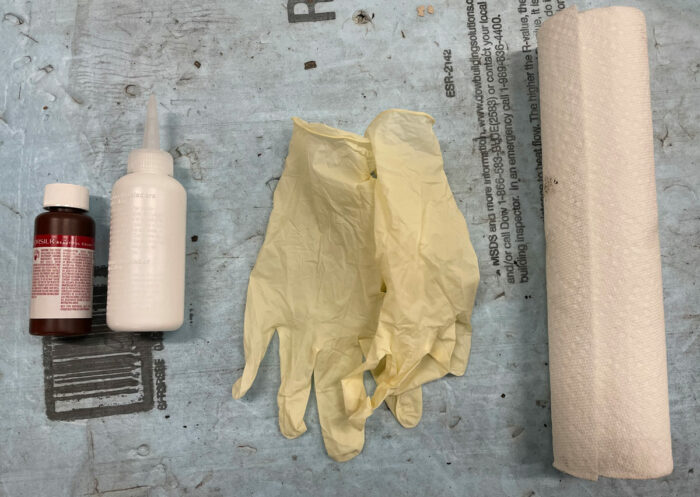
There are a few situations in woodworking where one needs to replicate the dark, solid black look of ebony. Whether you have a restoration on your bench and need to match a hardwood to the present ebony or your budget doesn’t accommodate purchasing one of the priciest hardwoods, using supermarket black hair dye can solve this dilemma.

Sourcing pitch-black solid Gabon ebony (Diospyros dendo) has become more difficult over the past 10 years due to deforestation and much needed regulations. A group of colleague luthiers and I began experimenting with ways to take less expensive streaky ebony such as Macassar (Diospyros celebica) and staining it to look solid black. I’ve tried vinegar and steel wool, penetrating stains, and black TransTint, but I have found black hair dye to be the easiest, most readily available, and most consistent product.
I start with a very plain piece of maple. Choose your grain direction carefully as you will see the grain in the final product. Plane, sand, or scrape the material to its final dimensions because you should no longer work the material after you have stained it. Think of it as a finish. After the material is at its final dimension, sand through the grits until you reach at least 600 grit. This will help replicate the natural sheen of ebony. If you use an orbital sander, I recommend sanding with the grain between grits to eliminate the swirl marks.
Once the maple has been sanded to a polished/burnished level it is time to prepare for the dyeing. If the work piece is already glued up and is attached to the project, make sure neighboring woods you would not like dyed black have finish on them, and are taped off. This is a very messy job and can ruin other neighboring hardwoods if the hair dye runs.

Cover your bench with either newspaper, plexiglass, or foam insulation to prevent staining your work surface. Wear an apron and latex gloves and have a large roll of paper towels on standby. Mix the hair dye as directed on the box. You can also mix smaller portions using a digital scale to measure out even 1:1 ratios. Once the dye is mixed evenly, it is time to apply it to your maple.

Apply a thick, even layer of hair dye across the entire surface you are ebonizing. Using a palette knife or a wood stir stick will help to create a solid thick layer. After about 20 minutes, I begin removing little sections of hair dye to make sure the wood is changing. The work time for the dye is a few hours so you have plenty of time to apply a second coat.

After you are content with the color, wipe off the excess hair dye with paper towels. Let the maple dry completely. At this point I like to add a few layers of Zinsser shellac in a spray can. If you wipe on a finish first, you risk removing hair dye that did not penetrate deep into the maple. With a few coats of shellac on, you can now complete the whole project with your choice of finish.

With the limited amount of the endangered ebony trees in the world, I find “ebonizing” other more sustainable hardwoods to be an easy solution. This saves the ebony for the finer workpieces and projects in our future.

Mitch Moehring is an award-winning luthier specializing in custom double basses using unconventional tonewoods. Based in Kilgore, Texas, Mitch enjoys using his large musical instrument making shop to complete other woodworking projects for his family and friends. Mitchmoehring.com Instagram @mitchmoehring







